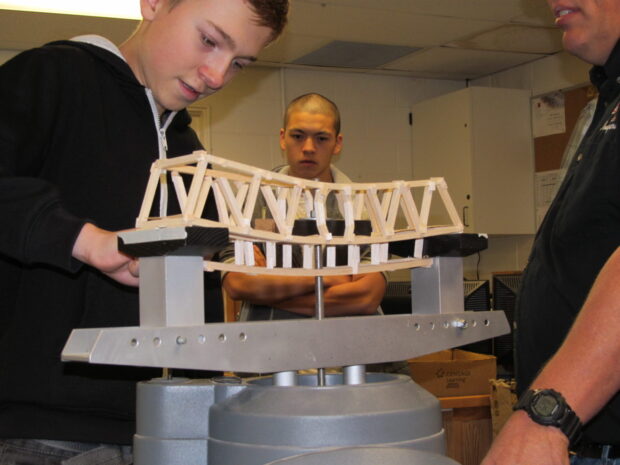ST. ANTHONY — South Fremont High School is taking the STEM approach to learning to another level — and educators there say it’s boosting standardized test scores and helping more kids prepare for college.
The rural, Eastern Idaho high school, located in the heart of potato country, is in its fourth year as a STEAM school. Like the widely adopted STEM approach to learning, STEAM emphasizes science, technology, engineering and math — but also throws art into the equation. (Hence, the added A in the acronym.)
“You’re looking at a 25-year music teacher,” said South Fremont principal Larry Bennett, who helped oversee the school’s 2013 implementation of STEAM. “You don’t have to tell us that art is an important part of education.”
But STEAM’s added emphasis isn’t the only thing that appears to be boosting certain areas of academics at South Fremont. Teachers have laced the program with variety of project-based assessments and Common Core-aligned writing prompts that they say work within STEAM’s broader framework to improve SAT scores and get more kids ready for college.
South Fremont’s SAT scores in comparison to statewide averages since 2012:
– 2012: reading: -8 percentage points; writing: -5 percentage points; math: -7 percentage points
– 2013: reading: -7.3 percentage points; writing: -4.9 percentage points; math: -4.2 percentage points
– 2014: reading: -4.5 percentage points; writing: -0.5 percentage points; math: -2.2 percentage points
– 2015: reading: -4.6 percentage points; writing: -1.6 percentage points; math: +.7 percentage points
– 2016: reading: -5 percentage points; writing -2 percentage points; math -1 percentage points
Since 2012, the school’s SAT scores have edged closer to state averages by at least 3 percentage points in both reading and writing. The school’s math scores, meanwhile, have jumped 6 percentage points closer to state averages.
Though South Fremont’s average SAT scores still rest below the rest of the state’s, teachers and students credit STEAM with improved performance in a variety of other areas — especially writing.
“Our writing skills were so bad before (STEAM) that it was embarrassing,” said Bonnie Warne, a 30-year English language arts teacher at South Fremont High School. “Now we have kids coming back to the high school and saying that the writing skills they picked up through STEAM are playing a key role in their success both here and in college.”
South Fremont Senior Natalie Chelson said STEAM’s emphasis on writing has boosted her confidence going into college. As part of the program, graduating seniors get a chance to look back on some of their freshman writings to gauge areas of academic growth.
“I actually got embarrassed when I looked back at my earlier writing,” she said. “It was like a quarter of a page and mostly not good. Now, I can write a page-and-a-half of good content, no problem.”
Bringing STEAM to South Fremont
South Fremont started its STEAM program in partial response to a statewide push to improve college go-on rates.
“We’ve just sort of been pounded in the hole from leaders about this so much over the years,” Bennett said. “We felt like we had to do something.”
But it wasn’t just the state’s call to get more kids enrolled in college that enticed Bennett and other educators at South Fremont to begin rethinking their approach to teaching. Feedback gleaned from educators at nearby BYU-Idaho suggested that many Eastern Idaho students were entering college without the writing skills necessary to succeed, Bennett said.

“Writing is central to almost everything you do in college, so that was one area we wanted to improve upon,” he added.
Bennett decided to form a committee of 12 South Fremont teachers to look for solutions. In terms of boosting college go-on rates, the group liked the interdisciplinary and applied approach offered through STEM, but wanted something that also provided rigorous study in the arts, from visual to musical to written.
The group soon discovered and settled on STEAM, which offers both a broader focus of material and a postsecondary emphasis.
Teachers also didn’t have to look far to start helping kids improve upon their writing, Bennett said: Common Core’s heavy emphasis on essays aimed at gauging student understanding would fit nicely, and STEAM’s broader range of material would give students plenty to write about.
How it works
South Fremont’s STEAM program centers around “inquiry projects” that require students to showcase and evaluate in writing each semester their growing knowledge and skills in anyone of STEAM’s five major areas of focus.
These projects range from social science experiments aimed at understanding how young children view the world to mini engineering feats, like designing and building a small bridge or catapult.
The finished projects are put on display throughout the school and on two 50-inch television screens near the front entrance.

“We think it’s important to recognize the work they do,” Bennett said.
Though students get to choose what to create, they must complete specific Common Core writing prompts tied to their area of focus. For example, art projects can range from creative stories and sculptures to playing in the school band, but all students within the artistic area of focus must address the following Core-aligned questions in writing:
- “What have I created that is aesthetically pleasing by using painting, sculpture, drawing, music, dance, wood, metal, food, fabric, words, or other medium?
- “How have I made it aesthetically pleasing?”
To better prepare students for the rigors of college, Bennett said, teachers are holding the quality of writing to a much higher standard. Teachers grade the essays with the help of a detailed rubric, which either gives the kids all the points or no points for the required portion of the assignment.
“(Students) are granted three minor mistakes when we grade their paper,” Bennett said. “These include minor errors, such as a missed comma. Anything beyond that and the kids have to fix their papers and resubmit.”
